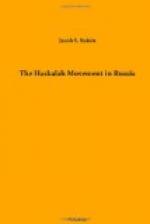The Russian Jews—says Zunser—sobered down from the orgies of assimilation, and its worshippers abandoned their idol. Those who had almost forgotten that they were of the camp of Israel began to return to its tents. The Jewish physicians, jurists, technologists, and the entire so-called Jewish “intelligentia,” who heretofore had never cared to speak a word of Yiddish to a Jew, resumed their native tongue; they began to send their children to the Jewish hadarim, and adopted once more Jewish ways and customs. Several hundred Jewish university students, proverbially irreligious, sent to Vilna for tefillin [phylacteries]!
In many cities fasts were observed and prayers for forgiveness offered, and the prodigal sons of Israel repaired to the synagogue, participated in the services, and wept with their more steadfast though equally unfortunate coreligionists. Many converts, too, began to feel qualms of conscience, and endeavored to make up for their youthful indiscretions. Some of them fled to places of safety, and returned to Judaism. The gifted young poet Simon Yakovlevich Nadsohn died of a broken heart. Sorkin, the classmate and friend of Levanda, committed suicide, while Levanda, the great novelist of assimilation, was so affected by the massacres and their consequences, that he became melancholy, and died in an asylum for the insane.[6]
If this was the fate of the assimilated and estranged, one may guess the effect of the reaction on the religious. If the students of the universities sacrificed their careers, their daily bread, for the austere satisfaction of discharging their moral obligation to the best of their knowledge, the students of the Law, always loyal to the heritage of their people, became more zealous than ever. Lilienblum who, in 1877, believed that life without a university education was not worth living, became a repentant sinner. Russian Jewry seethed with religious enthusiasm. Moses Isaac Darshan, “the Khelmer Maggid,” preached for six hours at a time to crowded synagogues. Asher Israelit, less trenchant, but equally effective, exhorted crowds to repentance. Zebi Hirsh Masliansky, a finished orator, went from town to town, and aroused a love for whatever was connected with the history and religion of the Jewish people. In Kovno those who were preparing themselves for the rabbinate formed something like a new sect, the Mussarnikes (Moralists), which practiced asceticism and self-abnegation to an extraordinary degree.[7]




